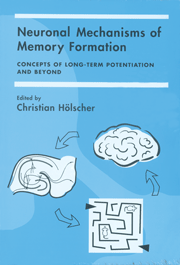Book contents
- Frontmatter
- Contents
- Contributors
- Introduction: Long-Term Potentiation as a Model for Memory Mechanisms: The Story So Far
- Section One Long-Term Potentiation In Vitro and In Vivo: How Can We Fine-Tune the Current Models for Memory Formation?
- Section Two There is More to the Picture Than Long-Term Potentiation: Theta or Gamma Oscillations in the Brain and the Facilitation of Synaptic Plasticity
- Section Three Making Models from Empirical Data of Synaptic Plasticity
- Section Four Setting the Stage for Memory Formation: Stress, Arousal, and Attention
- Section Five Transgenic Mice as Tools to Unravel the Mechanisms of Memory Formation
- 17 In Vivo Recording of Single Hippocampal Place Cells in Behaving Transgenic Mice
- 18 Understanding Synaptic Plasticity and Learning through Genetically Modified Animals
- 19 What Gene Activation Can Tell Us about Synoptic Plasticity and the Mechanisms Underlying the Encoding of the Memory Trace
- Conclusions and Future Targets
- Index
18 - Understanding Synaptic Plasticity and Learning through Genetically Modified Animals
Published online by Cambridge University Press: 13 October 2009
- Frontmatter
- Contents
- Contributors
- Introduction: Long-Term Potentiation as a Model for Memory Mechanisms: The Story So Far
- Section One Long-Term Potentiation In Vitro and In Vivo: How Can We Fine-Tune the Current Models for Memory Formation?
- Section Two There is More to the Picture Than Long-Term Potentiation: Theta or Gamma Oscillations in the Brain and the Facilitation of Synaptic Plasticity
- Section Three Making Models from Empirical Data of Synaptic Plasticity
- Section Four Setting the Stage for Memory Formation: Stress, Arousal, and Attention
- Section Five Transgenic Mice as Tools to Unravel the Mechanisms of Memory Formation
- 17 In Vivo Recording of Single Hippocampal Place Cells in Behaving Transgenic Mice
- 18 Understanding Synaptic Plasticity and Learning through Genetically Modified Animals
- 19 What Gene Activation Can Tell Us about Synoptic Plasticity and the Mechanisms Underlying the Encoding of the Memory Trace
- Conclusions and Future Targets
- Index
Summary
SUMMARY
Long-term potentiation (LTP) remains the most attractive model for learning-related plasticity. Of course, we must always test alternative hypotheses and be prepared to abandon those that no longer fit the existing data or provide predictive validity. Nonetheless, the LTP hypothesis for learning and memory has so much more data behind it than any alternative, I believe we are justified in continuing to test it rigorously using all available methods.
Among the most useful methods are those that involve direct manipulation of genes to disrupt LTP and learning. The use of genetic mutations to study learning and memory has a long history, but within the past decade its use has increased dramatically, driven by the development of techniques for targeted gene manipulation in mammals. Although these techniques are still essentially lesions, they have nonetheless increased the range of experiments that can be used to test the hypothesis that some forms of LTP underlie some forms of learning.
Introduction: A Brief History of Gene Manipulation in Long-Term Potentiation, Learning, and Memory
The intentional manipulation of genes has been going on for as long as humans have bred domesticated animals to select desirable physical or behavioral characteristics (Darwin, 1859). In the laboratory, this process dates back at least to Tryon (1934), who bred successive generations of rats on the basis of their performance in a complex maze. After several generations, there was nearly complete separation of performance in the maze, with “maze-dul “ rats making significantly fewer errors than “maze-bright” ones.
- Type
- Chapter
- Information
- Neuronal Mechanisms of Memory FormationConcepts of Long-term Potentiation and Beyond, pp. 427 - 449Publisher: Cambridge University PressPrint publication year: 2000



